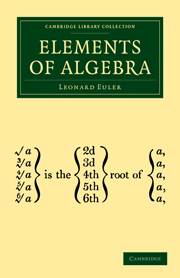Book contents
- Frontmatter
- ADVERTISEMENT
- MEMOIR OF THE LIFE AND CHARACTER OF EULER, BY THE LATE FRANCIS HORNER, ESQ., M. P.
- ADVERTISEMENT BY THE EDITORS OF THE ORIGINAL, IN GERMAN
- ADVERTISEMENT BY M. BERNOULLI, THE FRENCH TRANSLATOR
- Contents
- PART I Containing the Analysis of Determinate Quantities
- SECTION I Of the Different Methods of calculating Simple Quantities
- SECTION II Of the different Methods of calculating Compound Quantities
- SECTION III Of Ratios and Proportions
- SECTION IV Of Algebraic Equations, and of the Resolution of those Equations
- Chap. I Of the Solution of Problems in General
- Chap. II Of the Resolution of Simple Equations, or Equations of the First Degree
- Chap. III Of the Solution of Questions relating to the preceding Chapter
- Chap. IV Of the Resolution of two or more Equations of the First Degree
- Chap. V Of the Resolution of Pure Quadratic Equations
- Chap. VI Of the Resolution of Mixed Equations of the Second Degree
- Chap. VII Of the Extraction of the Roots of Polygonal Numbers
- Chap. VIII Of the Extraction of Square Roots of Binomials
- Chap. IX Of the Nature of Equations of the Second Degree
- Chap. X Of Pure Equations of the Third Degree
- Chap. XI Of the Resolution of Complete Equations of the Third Degree
- Chap. XII Of the Rule of Cardan, or that of Scipio Ferreo
- Chap. XIII Of the Resolution of Equations of the Fourth Degree
- Chap. XIV Of the Rule of Bombelli, for reducing the Resolution of Equations of the Fourth Degree to that of Equations of the Third Degree
- Chap. XV Of a new Method of resolving Equations of the Fourth Degree
- Chap. XVI Of the Resolution of Equations by Approximation
- PART II Containing the Analysis of Indeterminate Quantities
- ADDITIONS BY M. DE LA GRANGE
Chap. XVI - Of the Resolution of Equations by Approximation
Published online by Cambridge University Press: 05 July 2011
- Frontmatter
- ADVERTISEMENT
- MEMOIR OF THE LIFE AND CHARACTER OF EULER, BY THE LATE FRANCIS HORNER, ESQ., M. P.
- ADVERTISEMENT BY THE EDITORS OF THE ORIGINAL, IN GERMAN
- ADVERTISEMENT BY M. BERNOULLI, THE FRENCH TRANSLATOR
- Contents
- PART I Containing the Analysis of Determinate Quantities
- SECTION I Of the Different Methods of calculating Simple Quantities
- SECTION II Of the different Methods of calculating Compound Quantities
- SECTION III Of Ratios and Proportions
- SECTION IV Of Algebraic Equations, and of the Resolution of those Equations
- Chap. I Of the Solution of Problems in General
- Chap. II Of the Resolution of Simple Equations, or Equations of the First Degree
- Chap. III Of the Solution of Questions relating to the preceding Chapter
- Chap. IV Of the Resolution of two or more Equations of the First Degree
- Chap. V Of the Resolution of Pure Quadratic Equations
- Chap. VI Of the Resolution of Mixed Equations of the Second Degree
- Chap. VII Of the Extraction of the Roots of Polygonal Numbers
- Chap. VIII Of the Extraction of Square Roots of Binomials
- Chap. IX Of the Nature of Equations of the Second Degree
- Chap. X Of Pure Equations of the Third Degree
- Chap. XI Of the Resolution of Complete Equations of the Third Degree
- Chap. XII Of the Rule of Cardan, or that of Scipio Ferreo
- Chap. XIII Of the Resolution of Equations of the Fourth Degree
- Chap. XIV Of the Rule of Bombelli, for reducing the Resolution of Equations of the Fourth Degree to that of Equations of the Third Degree
- Chap. XV Of a new Method of resolving Equations of the Fourth Degree
- Chap. XVI Of the Resolution of Equations by Approximation
- PART II Containing the Analysis of Indeterminate Quantities
- ADDITIONS BY M. DE LA GRANGE
Summary
784. When the roots of an equation are not rational, whether they may be expressed by radical quantities, or even if we have not that resource, as is the case with equations which exceed the fourth degree, we must be satisfied with determining their values by approximation; that is to say, by methods which are continually bringing us nearer to the true value, till at last the error being very small, it may be neglected. Different methods of this kind have been proposed, the chief of which we shall explain.
785. The first method which we shall mention, supposes that we have already determined, with tolerable exactness, the value of one root; that we know, for example, that such a value exceeds 4, and that it is less than 5. In this case, if we suppose this value = 4 + p, we are certain that p expresses a fraction. Now, as p is a fraction, and consequently less than unity, the square of p, its cube, and, in general, all the higher powers of p, will be much less with respect to unity; and, for this reason, since we require only an approximation, they may be neglected in the calculation. When we have, therefore, nearly determined the fraction p, we shall know more exactly the root 4 + p; from that we proceed to determine a new value still more exact, and continue the same process till we come as near the truth as we desire.
- Type
- Chapter
- Information
- Elements of Algebra , pp. 289 - 298Publisher: Cambridge University PressPrint publication year: 2009First published in: 1822

